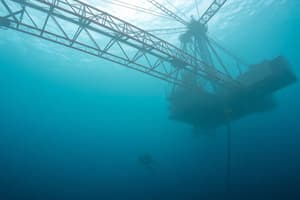Podcast
Questions and Answers
In the described incident, what direct action led the Diving Supervisor to incorrectly assume the crane hook had reached the seabed?
In the described incident, what direct action led the Diving Supervisor to incorrectly assume the crane hook had reached the seabed?
- The diver reporting the hook was close to the seabed.
- The crane operator stating there was 'no weight' on the crane wire. (correct)
- Visual confirmation of the hook's position by underwater cameras.
- A pre-lift meeting confirming the hook's position.
What control measure could most effectively address the root cause of the crane hook incident during subsea operations?
What control measure could most effectively address the root cause of the crane hook incident during subsea operations?
- Mandatory use of thicker diving helmets.
- Implementing stricter regulations for diver qualifications.
- Specifying minimum lengths for crane pennant/stinger to ensure adequate distance. (correct)
- Increasing the speed of crane operations to reduce time underwater.
Besides a correctly sized pennant/stinger, which additional measure would best improve safety by enhancing situational awareness during similar subsea operations?
Besides a correctly sized pennant/stinger, which additional measure would best improve safety by enhancing situational awareness during similar subsea operations?
- Limiting the dive time to 30 minutes.
- Using only experienced dive teams.
- Implementing additional locating beacons, underwater cameras, or sonar. (correct)
- Increasing the number of divers on the dive team.
In incident prevention, what is the most vital change in practice the incident report calls for?
In incident prevention, what is the most vital change in practice the incident report calls for?
According to the "What went right?" section, what was a key factor in preventing injury to the diver when struck by the crane hook?
According to the "What went right?" section, what was a key factor in preventing injury to the diver when struck by the crane hook?
Flashcards
Subsea Crane Hook Incident
Subsea Crane Hook Incident
When lowering equipment subsea, the crane hook unexpectedly struck a diver's helmet during spool tie-in operations due to miscommunication and poor visibility.
Cause of Unexpected Hook Strike
Cause of Unexpected Hook Strike
The crane operator assumed the hook had reached the seabed based on a 'no weight' reading, but it had only come to rest on the Pipe Handling Frame (PHF).
Contributing Factors
Contributing Factors
Inadequate crane pennant length, poor visibility, and assumptions about equipment position were key factors in the incident.
Preventative Actions
Preventative Actions
Signup and view all the flashcards
Enhance Subsea Visibility
Enhance Subsea Visibility
Signup and view all the flashcards
Study Notes
- During subsea spool tie-in operations, a crane hook unexpectedly struck a diver's helmet
Incident Details
- Divers were working on the seabed in poor visibility during subsea spool tie-in operations
- After landing the pipe handling frame (PHF) on the seabed, the Diving Supervisor told the crane operator to lower the crane hook to disconnect rigging
- The crane operator reported 'no weight' on the crane wire
- The Diving Supervisor, assuming the hook was on the seabed, instructed the diver to proceed with disconnecting the PHF
- The crane hook struck the diver's helmet while the diver was positioned beneath the PHF
- The diver reported being unharmed and immediately returned to the dive bell, and the dive was aborted
- The diver's reclaim helmet was damaged, including the side block, but maintained integrity
- The diver was unharmed
Positive Outcomes
- Diver 2 promptly assisted Diver 1, ensuring no injuries
- Both divers immediately returned to bell safely
- Locating beacons on divers and the crane block enabled accurate tracking
- All procedures, lifting plans, and Job Hazard Analysis (JHA's) were followed
- Protective equipment absorbed the impact
What Went Wrong
- The crane hook rested on the PHF beam, leading to a 'no weight' reading
- The crane operator assumed the hook had reached the seabed
- As the diver approached the disconnection point, the hook slipped and struck the helmet
Causes
- Inadequate crane pennant/stinger length did not provide sufficient distance between divers and the crane hook
- Poor visibility hindered the ability to see the crane hook
Lessons and Actions
- Ensure adequate distance between divers and crane hook
- The crane pennant/stinger should maintain a safe distance, especially in limited visibility
- Enhance visibility aids and monitoring
- Use additional locating beacons, underwater cameras, or sonar to track critical equipment
- This can help prevent misjudgments about equipment location
- Reinforce communication and challenge assumptions
- Minimize assumptions regarding equipment position
- Clear communication between the dive supervisor, crane operator, and divers should ensure all parties are aware of the equipment's location
Additional Measures
- Updated project procedures to specify minimum pennant lengths
- Conduct pre-operation inspections of all rigging and lifting equipment
- Updated the Job Hazard Analysis (JHA) to incorporate lessons learned, regarding safe distances, visibility, and communication
Studying That Suits You
Use AI to generate personalized quizzes and flashcards to suit your learning preferences.




